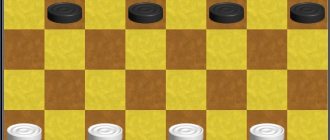Introductory part
Purpose: To introduce students to the concept of “positional advantage” in checkers.
Tasks:
- form the concepts of “strong position”, “weak position”;
- teach children to solve exercises with positional advantage in practice;
- develop intelligence, visual memory,
- to develop interest in the game of checkers;
- cultivate perseverance, thoughtfulness, and the will to win.
Equipment and materials : magnetic board, colored magnets, magnetic checker boards, checkers.
Age : 4th grade.
Summary of the lesson “Miracle of Checkers” for middle-aged children.
Author: Konstantinova Daria Sergeevna
teacher at Children's Preschool Educational Institution "Kolobok"
Summary of the lesson “Miracle of Checkers” for middle-aged children.
Direct educational activity
“Miracle of Checkers”
Purpose:
Teach children to play checkers.
Tasks:
To consolidate children's knowledge about the game of checkers, to consolidate the rules of the game, the ability to use number as a result of measurement, to determine the equality of several groups of objects by number (the same number, 32, 12 each, the same number, equally, the concepts of even and odd numbers.
Exercise in the ability to navigate on a plane, consolidate concepts: vertical, horizontal lines, introduce the diagonal line, in the ability to create an activity algorithm.
Enrich children's vocabulary with new words: checkers player, tournament, partner, diagonal, draw.
Develop an interest in the game of checkers, the ability to be friendly and respectful towards each other, the desire to strive for success, and cultivate a sense of self-confidence.
Material:
Checkers.
Progress of activities:
— I want to inform you that this month in our city there will be a checkers tournament among children who go to kindergartens. Would you like to take part?
Then I suggest you start preparing for this tournament, remember everything we know about the game of checkers and consolidate the rules of the game.
I.
— Guys, how many of you know what a tournament is? (type of competition)
— What is the name of the person who plays checkers? (Checkers player)
- What should a checkers player be like? (Well-mannered, seasoned, kind, etc.)
— What do you need to play checkers? (Partner, checkers board, checkers, knowledge of the rules of the game)
Children present an algorithm.
- Who can play checkers? (Anyone)
— Who can be a partner for the game? (Anyone)
— How do partners greet each other at the beginning and end of the game? (Shake hands at the beginning and end of the game)
II.
— Guys, the checkers board is very unusual and is fraught with a lot of mysterious mysteries. Let's try together to unravel and declassify all the strange secrets of the magic board.
The children sit at the tables.
- I will ask you questions, and you try to answer them accurately, carefully peering at the checkers board, slowly studying it.
- What do you see on the board? (Identical small squares that alternate in color)
- How are they similar and how are they different? (Similar in shape and size, but different in color)
- “All in squares - white, black, checkerboard ...”
Count how many white and black cells there are? Boys count white squares, and girls count black squares. (White cells 32, black cells 32)
- What can be said about the number of black and white cells? (The same number, equally, 32 each, as many whites as there are blacks)
- I want to tell you that cells can be white and brown, white and green, white and red, but they are always called white and black.
What is the name of each of the squares or cells? (Field)
— Check, have you positioned your boards correctly?
Remember that the corner box on the right is always white, and the corner box on the left is always black.
- Do you know that the checkers board consists not only of square fields, but also of many different paths, paths, and they have different names.
What are the names of straight lines that go from left to right and right to left? (Horizontal lines)
- Count how many there are on the board? (8 horizontal lines)
- Now label each line with a number. The number is placed on the side to the left and right of the board. But we will only put it on the left. (performed with children)
- What are the lines that go from top to bottom and bottom to top called? (Vertical lines)
— Yes, and they are designated by numbers of the Latin alphabet. I suggest you draw one horizontal line with a blue pencil and one vertical line with a red pencil, and compare them in length.
—Which line is longer: horizontal or vertical? (Lines are equal)
- I suggest you play. To do this you need to split into two teams.
(Children take the numbers and divide them into even and odd)
— The evil wizard scattered the checker boards horizontally. We need to collect them, let's try! (Children do the task at the round table)
- Well done! You have defeated the evil wizard's cunning! But there are also lines on the checkerboard, they go diagonally - diagonal lines are certainly the same color. Our checkers will move only along black diagonal lines. Let's compare them by length. (Diagonal lines vary in length)
— You and I found out that horizontal lines are indicated by numbers, vertical lines by letters, these are the main lines. How are diagonal ones designated? Guys, diagonal lines are obtained from the intersection of vertical and horizontal lines, and are indicated by a letter and a number. For example, A1, L8.
— What else do you think is denoted by a letter and a number? (Cells - fields)
— Yes, each of the 64 fields has its own address, its own unique name. In checkers, it is customary to name the letter first and then the number.
Game "Find the field"
The teacher gives the children 2 chips with the address of the fields, and the children must find and place their chip in the correct field.
- So you got acquainted with the magic board and the place where checkers battles will be played out.
Physical exercise.
“And now I suggest you relax a little and play a game with magic palms.” Be very careful!
The teacher shows palms made of cardboard of different colors one by one,
purple - children freeze,
yellow - whispering,
red - they scream.
III.
— We have learned the secrets of the checkers board, but what else do we need to talk about? (about checkers)
Children sit at a round table.
— On which squares are the checkers located? (On black)
— How many checkers is given to each player? (12 checkers each)
— How are the checkers placed at the beginning of the game? (On three horizontal lines on each side)
"White squad, black squad,
Two armies are facing each other.
Strict order in a detachment alone,
Exactly the same in another squad"
— Which checkers by color start the first move? (white checkers)
— How to determine who should play what? (Using lots, in amateur games they simply hold 1 checker of a different color in both hands, and ask the partner to choose one of the two. Which checker he chose, that color is what he should play with)
IV.
— Any game, be it checkers or football, tennis or hockey, has its own rules of the game. Remember and name the rules that you know, and we will place them on the board.
Rules of the game
- Touched - go.
- With a “quiet move, the checker moves only forward”
- The queen can move in any direction and any distance.
- If the checker reaches the last horizontal line, it turns into a king.
- If there are several opponent's checkers along the path of the hitting checker, you need to hit them all.
- The shock stroke can be made both forward and backward.
- Capturing the opponent's checker is mandatory
Gentleman's rules.
- You should not give hints or distract your opponent’s attention.
- Don't laugh at someone else's loss.
- Remove checkers carefully, without unnecessary noise.
Conclusion: when playing checkers you need to behave like a well-mannered and cultured person.
— Guys, when is the game considered finished?
- if the opponent does not have a single chip left;
- if the opponent has chips, but cannot make a move, this happens when the checkers freeze;
- if the opponent admits himself defeated;
- in the event of a draw (this is the end of the game when no one is awarded victory)
V.: Remember that losing cannot be considered something shameful.
V.
- Guys, you are great! We went through the ABCs of the game of checkers and established the rules of the game.
- What if you don’t have a checkers board and checkers? (you can draw a checkerboard, and instead of chips take buttons, small caps, etc.)
- That’s right, but in order to quickly solve this problem, I’ll give each of you a checkers board, and you’ll choose the chips yourself.
- And now we will determine the champion, the strongest checkers player in the group. Forward to the victory!
Progress of the lesson
Organizational stage. Motivation
Teacher: Hello, guys. You are candidates for the school checkers team. Today this event will reveal which of you will make it to the main team of the school team, and which will become a reserve athlete.
Today we have 2 teams - “Checkers Players” and “Checkers Players”. And you have to conduct an intellectual battle to determine the best of equals.
And our experts Andrey and Alexey, who have the first youth level in checkers, will evaluate your work.
Goal setting. Technique “Speculation”
Teacher: Today we have a lesson, the topic of which you will give yourself using words - hints on the board (over, checkers, conditions, king, victory).
Hint: the first word is “Conditions” (children answer).
So, the topic of our lesson is: “Conditions for the victory of checkers over the king”
You already know that queens are stronger than checkers. Do you want to learn how to defeat your opponent's king with your checkers, or how to break a game in which your opponent has two kings and you only have checkers? (WANT!)
Okay, then name the purpose of our lesson, using one of the helping words (on the board): “Repeat”, “Study”, “Let’s find out”, “Check”.
So, what is the purpose of our lesson? (3-4 people say their goal)
And our common goal is to study the conditions under which checkers are stronger than kings.
Updating knowledge
Intellectual warm-up questions for teams taking turns: 3 sec. - to the answer.
- Is it necessary to capture other people's checkers and kings? (Yes).
- Is it possible that none of the players will win the game? (Yes).
- What is the longest diagonal "a - h" called? (“Big Road”)
- What are the names of the diagonals “b - 2” and “g - 7” and connecting them? ("Double").
- What are the names of the diagonals “c – 6” and “f – 3” and connecting them? ("Tee").
- What are the parallel diagonals “b - 7” and “g - 2” called? (“Doppelganger”).
- What are the parallel diagonals “c – 3” and “f – 6” called? (“Threesome”).
- What are the parallel diagonals “5 – d” and “e – 4” called? (“Job”).
- What is the advantage? (Material and positional)
- Which advantage is more beneficial? (Positional)
The task “True or false?”
Answer “True” or “False” to the following statement:
- The queen will always defeat one checker (No).
- The queen will always win 2 checkers (No).
- 4 queens will always beat 1 queen (Yes).
- 3 queens will always beat 1 queen (No).
- 2 queens will always beat 1 queen (No).
- 3 checkers standing in front of the “high road” can lead to a draw (Yes).
- 4 queens will always beat 2 queens (No).
- A queen standing on the “high road” will not lose to two queens (Yes).
- A queen standing on the “high road” will not lose to three queens (Yes).
- The checker always helps his queen (No).
Main stage (new topic)
Working with the text “Extract from the rules of the game of Russian checkers” (“Insert” technique) -5 min.
Teacher:
Raise your hand those who put a “–” sign in the text. And now those who have the “+” sign. And those who have the “?” icon.
Okay, so you worked with the text carefully, which we will check now.
2 questions for teams on the content of the text (for evaluation by experts):
- Can one participant propose a draw more than once? (Yes)
- Is it possible to correct a checker during an opponent's move? (No)
- Is it possible to move a checker or king across the same square several times? (Yes)
- Is it possible to achieve a draw in five moves? (Yes)
Explanation and demonstration of the solution to a checkers problem with a positional advantage in simple checkers versus kings.
Teacher: White and black each have 5 pieces. Who has the material advantage? (Black has 2 queens and 3 checkers versus White’s 5 checkers).
Can White use the position to his advantage? (They can, with the only correct move f 2 on e3, forcing the black king to capture the white checker, and the white checker g 3 will capture all the black pieces.)
Development of an open physical education lesson “Board game checkers”
Tactics “How to win at checkers”Help in the game, game control
You can often come across the opinion that it is not difficult to be able to play checkers , and the most that needs to be done for this is simply to study the rules of the game. But in order to win at checkers, knowing the rules of the game alone is completely insufficient. Of course, you need to know the rules of the game first, otherwise what is the point of playing a game without rules? However, the main question for any game, including checkers, is undoubtedly the question of how to play in such a way as to win. And if you don’t strive to win at checkers, why start playing them at all?
TACTICS “How to win at checkers”
· Tip 1. During the game, try to get your checkers into the kings and don’t let your opponent do this.
The Queen is a very formidable weapon, its strength lies in its long-range capabilities, as well as its ability to move in any direction (along the diagonals of the board). Even a lone queen can easily block the path of a whole group of opponent’s checkers.
· Tip 2. Try to ensure that your opponent’s checkers become smaller than yours.
The advice is also obvious, but how to use it? You need to force your opponent to give up his checkers or knock down your opponent’s checkers yourself. This can be done using various techniques. Here are the simplest of them: a simple technique to win the opponent’s checker is to enter the “lyubki”; a technique of the game is to attack the opponent’s weak checker.
· Tip 3. Occupy the central squares of the board with your checkers.
A checker located on a square at the edge of the board (side square) has less strength than a checker that occupies one of the squares in the center of the board.
When following this advice, you should act carefully, providing your central checkers with sufficient protection in the event of a possible attack on them by the opponent's checkers.
· Tip 4. Try to determine what your opponent might do in response and what the consequences will be.
Before you make a move, be careful, no matter how tempting this move may seem. In other words, in order to win, you must try to predict your opponent’s actions even before your maneuver, since if you guess your opponent’s plan too late, you may not have time to prevent it.
· Tip 5. Try to constantly think through your actions several moves ahead.
This is the so-called position calculation. The deeper and more accurate your calculation, the more opportunities you have to outplay your opponent.
The tips above are truly the simplest rules on how to win at checkers . In order to learn how to play checkers better, it is very important to study checkers books on your own. It should also be noted that all of these tips will give effect when applied together, but even following most of them does not guarantee unconditional victory in the game. This is one of the attractive aspects of the game of checkers; it is still not so easy for many to find the answer to the question of how to play checkers to win .
Methodological development of a lesson on checkers “Checkers notation and recording of games”
Instructions for distance learning in off-line mode
Educational program “Russian Checkers”, year 1
Topic of the lesson: “checkers notation and notation of games”
Good afternoon guys!
The topic of our lesson is “checkers notation and notation of games”
ABC of checkers
The initial arrangement of Russian checkers is shown in Diagram 1, with the black corner square of the large diagonal should be to the left of each opponent. Diagram 1 - starting position
| a | b | c | d | e | f | g | h |
| 8 | O | O | O | O | |||
| 7 | O | O | O | O | |||
| 6 | O | O | O | O | |||
| 5 | |||||||
| 4 | |||||||
| 3 | O | O | O | O | |||
| 2 | O | O | O | O | |||
| 1 | O | O | O | O |
Position - a specific arrangement of white and black checkers on the board, as well as a checkers game is written using checkers notation, consisting of eight numbers 1, 2, 3, 4, 5, 6, 7, 8 - indicating the numbers of the ranks, and eight Latin letters alphabet a, b, c, d, e, f, g, h - indicating verticals. Notation - there is an alphanumeric system for designating board fields for recording the position of checkers and moves. The fields are taken as the intersection points of verticals and horizontals. For example, the starting position in diagram 1 is written as follows:
white: a1, a3, b2, c1, c3, d2, e1, e3, f2, g1, g3, h2 (12) black: a7, b6, b8, c7, d6, d8, e7, f6, f8, g7, h6, h8 (12) White move
This entry replaces diagram 1. In this case, say, checker c3 is at the intersection of the vertical “c” and the third horizontal, checker f6 is at the intersection of the vertical “f” and the sixth horizontal, etc. So, when writing a position, the notation indicates the location of the forces of White and Black, in brackets the number of checkers and then the order of moves. Diagram 2 shows the designation of all the black squares on the checkerboard. Diagram 2
| 8 | b8 | d8 | f8 | h8 | |||
| 7 | a7 | c7 | e7 | g7 | |||
| 6 | b6 | d6 | f6 | h6 | |||
| 5 | a5 | c5 | e5 | g5 | |||
| 4 | b4 | d4 | f4 | h4 | |||
| 3 | a3 | c3 | e3 | g3 | |||
| 2 | b2 | d2 | f2 | h2 | |||
| 1 | a1 | c1 | e1 | g1 | |||
| a | b | c | d | e | f | g | h |
To record the move of a simple checker or king, first write down the serial number of the move, then the designation of the field on which the checker or king stood, then put a dash and sign the designation of the field on which it was placed. For example, the entry 1) c3-b4 f6-g5 means that White's move c3-b4 and Black's counter move f6-g5 are recorded, which is considered one move in the game. If a capture occurs, i.e. shock move, in contrast to the usual quiet move, then a colon is placed instead of a dash. Let's say the entry 7) a3:c5 means: 7 is the sequence number of the move; a3 - the field from which the move was made; (:) - a colon instead of a dash means that a battle has taken place, i.e. shock stroke; (-) - means a quiet move, without a fight; c5 is the square on which the move ends. The entry 8)...f6-e5 means that Black's eighth move is written (three dots after the sequence number of the move). The following popular notations are also used: = - draw; X - height; ! - good, strong move; !! - very strong, difficult to find move; ? - bad or weak movement; ?? - very bad, losing move; !? - a move whose assessment is unclear. Let's look at a specific example of recording a checkers game. A. Kovrizhkin - Z. Levin Kharkov, 1933 1. g3-f4 f6-e5 2. c3-d4 e5:c3 3. b2:d4 d6-c5 4. d2-c3 g7-f6 5. h2-g3 h8 -g7 6. c1-b2 f6-g5 7. g3-h4 g7-f6 8. f4-e5 f8-g7? Diagram 3
| 8 | O | O | |||||
| 7 | O | O | O | O | |||
| 6 | O | O | O | ||||
| 5 | O | O | O | ||||
| 4 | O | O | |||||
| 3 | O | O | O | ||||
| 2 | O | O | |||||
| 1 | O | O | O | ||||
| a | b | c | d | e | f | g | h |
white: a1, a3, b2, c3, d4, e1, e3, e5, f2, g1, h4 (11) black: a7, b6, b8, c5, c7, d8, e7, f6, g5, g7, h6 ( 11) Black's eighth move loses. Should have played 8…e7-d6 9. e5:g7 f8-e7 10. h4:f6 h6:f8 11. c3-b4 e7:g5 12. b4-a5 d8-e7 13. f2-g3 g5-f4 14. e3 :g5 c5:e3 15. g3-f4 e7-f6 etc. Let us return, however, to the main trend of the party. A system of abbreviated (short) notation is also used. In this case, the field from which a move is made is indicated only by a letter and a dash is omitted, and the field on which a checker is placed as a result of a move made or captured is indicated by a letter and a number. For example, 1)cb4 fg5. The colon indicating a shock move is left, for example, 7)a:c5. It happens that a certain move must be written down in full notation. For example, the various takes 10) a5:c3 and 10) c1:c3 in the abbreviated notation - 20) a:c3 do not differ. The above game in brief notation is written as follows: 1.gf4 fe5 2.cd4 e:c3 3.b:d4 dc5 4.dc3 gf6 5.hg3 hg7 6.cb2 fg5 7.gh4 gf6 8.fe5 fg7? 9.ef4!! g:e3 (If you beat 9...c:e3 10.f:d2 f:d4 11.h:h8X) 10.gh2 e:g1 11.cb4 c:e3 12.ef2 f:d4 13.hg5 h:f4 14 .bc3 d:b2 15.f:d4 g:c5 16.b:c1 , and Black resigned.
Guys, look at this link https://drive.google.com/file/d/11woESutcTNXje496KI-tSGI75G0sgaxr/view?usp=drivesdk
the most important thing is that it will be useful to you in competitions.
D/3
Play the game in full, both for yourself and for the person who will play with you, on a piece of paper, take a photo and send me your recording of the game in a private message. I’ll take it apart, see how it turned out - if anything needs to be done, we’ll correct it.
Thank you for attention.
Resource used https://www.kombinashki.ru/okon_page1.php





